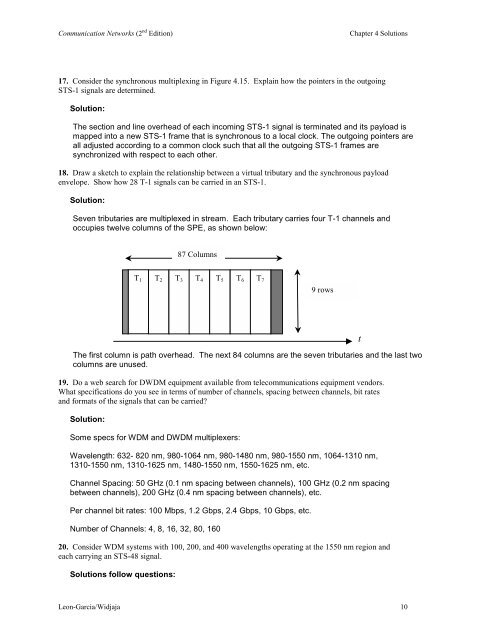Solutions to Chapter 4 - Communication Networks
Solutions to Chapter 4 - Communication Networks
Solutions to Chapter 4 - Communication Networks
Create successful ePaper yourself
Turn your PDF publications into a flip-book with our unique Google optimized e-Paper software.
<strong>Communication</strong> <strong>Networks</strong> (2 nd Edition)<br />
<strong>Chapter</strong> 4 <strong>Solutions</strong><br />
17. Consider the synchronous multiplexing in Figure 4.15. Explain how the pointers in the outgoing<br />
STS-1 signals are determined.<br />
Solution:<br />
The section and line overhead of each incoming STS-1 signal is terminated and its payload is<br />
mapped in<strong>to</strong> a new STS-1 frame that is synchronous <strong>to</strong> a local clock. The outgoing pointers are<br />
all adjusted according <strong>to</strong> a common clock such that all the outgoing STS-1 frames are<br />
synchronized with respect <strong>to</strong> each other.<br />
18. Draw a sketch <strong>to</strong> explain the relationship between a virtual tributary and the synchronous payload<br />
envelope. Show how 28 T-1 signals can be carried in an STS-1.<br />
Solution:<br />
Seven tributaries are multiplexed in stream. Each tributary carries four T-1 channels and<br />
occupies twelve columns of the SPE, as shown below:<br />
87 Columns<br />
T 1 T 2 T 3 T 4<br />
T 5 T 6 T 7<br />
9 rows<br />
t<br />
The first column is path overhead. The next 84 columns are the seven tributaries and the last two<br />
columns are unused.<br />
19. Do a web search for DWDM equipment available from telecommunications equipment vendors.<br />
What specifications do you see in terms of number of channels, spacing between channels, bit rates<br />
and formats of the signals that can be carried<br />
Solution:<br />
Some specs for WDM and DWDM multiplexers:<br />
Wavelength: 632- 820 nm, 980-1064 nm, 980-1480 nm, 980-1550 nm, 1064-1310 nm,<br />
1310-1550 nm, 1310-1625 nm, 1480-1550 nm, 1550-1625 nm, etc.<br />
Channel Spacing: 50 GHz (0.1 nm spacing between channels), 100 GHz (0.2 nm spacing<br />
between channels), 200 GHz (0.4 nm spacing between channels), etc.<br />
Per channel bit rates: 100 Mbps, 1.2 Gbps, 2.4 Gbps, 10 Gbps, etc.<br />
Number of Channels: 4, 8, 16, 32, 80, 160<br />
20. Consider WDM systems with 100, 200, and 400 wavelengths operating at the 1550 nm region and<br />
each carrying an STS-48 signal.<br />
<strong>Solutions</strong> follow questions:<br />
Leon-Garcia/Widjaja 10







